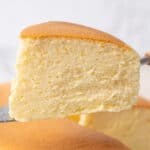Jiggly Japanese Cheesecake
This Jiggly Japanese Cheesecake recipe is the ultimate fluffy, souffle-like cheesecake that some refer to as Japanese Cotton cheesecake due to its unique texture.
Servings: 8
Calories: 258kcal
Equipment
- 20 cm / 8 inch cake pan
Ingredients
- 226 g Cream cheese full fat Philadelphia
- 55 g Unsalted butter
- 120 g Whole milk
- 40 g All purpose flour low protein content flour e.g. pastry flour is ideal
- 15 g Corn starch
- Pinch of salt
- 5 medium Eggs yolk and white separetely
- 75 g Granulated sugar superfine sugar is ideal
Instructions
- Line a 20 cm (8-inch) round cake pan with parchment paper, and preheat the oven to 150°C (300°F) with a water bath inside. Ensure the water bath reaches about halfway up the sides of the cake tin to promote even baking and prevent cracks.
- If using a loose-base pan, wrap it thoroughly with aluminum foil to keep water from getting into the cheesecake.
- In case your sugar granulates on the larger side, pulse it in a blender to make superfine sugar, then measure the amount needed. Separate the eggs into yolks and whites.
- Place the cream cheese, butter, and milk in a saucepan over low heat, stirring until completely smooth, then remove from heat.
- Sift the cornstarch, salt, and flour. Add them to the cream cheese mixture, until the batter is smooth and free of lumps.
- Then, add the egg yolks to the cream cheese mixture one at a time, mixing thoroughly after each addition.
- Using a stand mixer or hand mixer, start whipping the egg whites on low speed. Gradually add the sugar one tablespoon at a time, increasing the mixer speed as you go, and continue until the mixture forms soft peaks.
- Gently fold the whipped meringue into the cream cheese batter with a rubber spatula, ensuring the mixture stays light and fluffy.
- Then, pour the batter into the prepared cake pan, and place it in the water bath to bake. Start by baking at 150°C (300°F) for 30 minutes with the oven door closed, then continue at the same temperature for another 20 minutes with the oven door slightly open. Finish with an additional 20 minutes at 150°C (300°F) with the oven door closed, using a digital oven thermometer if available to confirm accuracy.
- Keep an eye on the cheesecake as it bakes; aim for a gentle rise to avoid cracking on the surface. Look for a golden-brown top—fully colored but not burnt—and adjust the temperature if needed to achieve this.
- The biggest question is when to take the Japanese cheesecake out of the oven and this is where you might need to experiment with your oven and run 1-2 tests. In practise, take the cheesecake out of the oven when it has a golden-brown top, a slight jiggle in the center, and feels soft and springy to the touch.
Notes
INGREDIENT NOTES
- Always use unsalted butter in baking and add salt separately.
- I suggest using full-fat cream cheese and milk.
- For the flour, try to look for low protein content pastry flour.
- When separating the eggs, make sure no yolk goes into the white part, as that would make it difficult to whip up. It’s easier to separate eggs when they’re cold, as the yolks are firmer and less likely to break. However, for most baking, incl. this Japanese cheesecake, it’s best to let the separated whites and yolks reach room temperature before mixing, as they whip and incorporate better.
- Be careful not to overwhip the egg white; check the consistency regularly to avoid stiff peaks. Stiff peaks tend to form lumps and is very difficult to fold with the rest of the ingredients.
- To keep the batter airy while folding in the meringue, use a rubber spatula to cut through the center of the mixture, then sweep along the sides of the bowl, lifting the batter gently. Rotate the bowl with each fold, working firmly but gently to avoid deflating the meringue.
- The baking part is absolutely critical when making Japanese cheesecake. The most common reason for the cheesecake top to crack is a too-high oven temperature - cheesecake rising too quickly.
- A water bath, or bain-marie, is used to create a gentle and consistent heat around delicate baked goods like cheesecakes and custards. The water insulates the pan, helping the dessert bake evenly without direct high heat, which reduces the risk of cracking, drying out, or curdling. It also helps maintain a moist texture, giving cheesecakes a smooth, creamy finish.
Nutrition
Calories: 258kcal | Carbohydrates: 17g | Protein: 6g | Fat: 18g | Saturated Fat: 10g | Polyunsaturated Fat: 1g | Monounsaturated Fat: 5g | Trans Fat: 0.2g | Cholesterol: 147mg | Sodium: 135mg | Potassium: 105mg | Fiber: 0.2g | Sugar: 11g | Vitamin A: 724IU | Calcium: 64mg | Iron: 1mg
